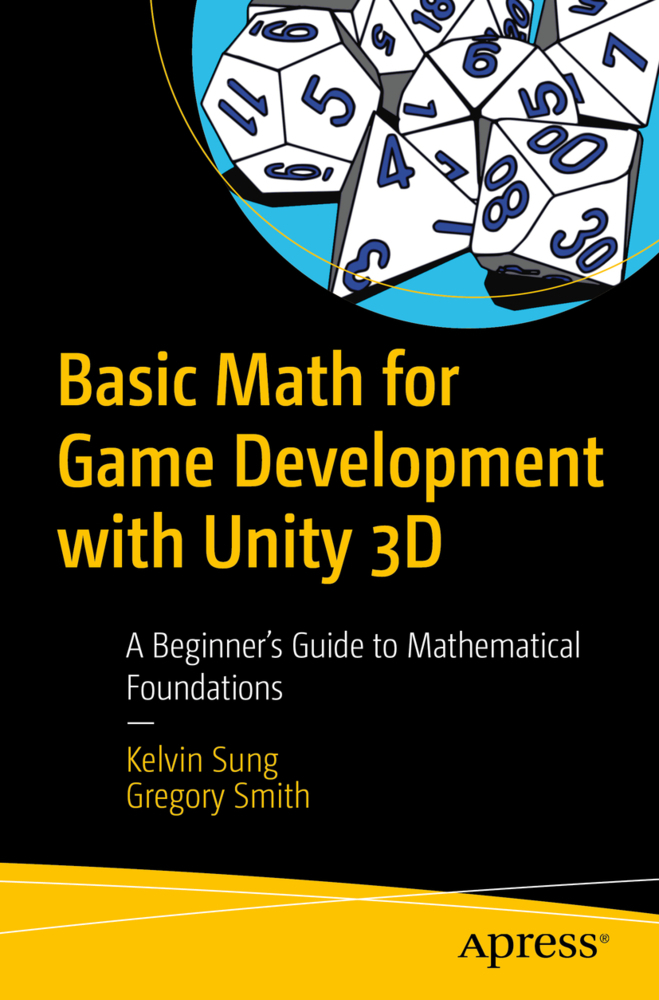48,14 €*
Versandkostenfrei per Post / DHL
Aktuell nicht verfügbar
What You Will LearnUnderstand the basic concepts of points and vectors and their applications in game developmentApply mathematical concepts to modern video game functionality, such as spherical and box collidersImplement autonomous behaviors, including following way points, facing a target, chasing an object, etc.Who This Book is ForBeginners, and those interested in the implementation of interactive games, who need a basic mathematical background or a refresher with modern examples
What You Will LearnUnderstand the basic concepts of points and vectors and their applications in game developmentApply mathematical concepts to modern video game functionality, such as spherical and box collidersImplement autonomous behaviors, including following way points, facing a target, chasing an object, etc.Who This Book is ForBeginners, and those interested in the implementation of interactive games, who need a basic mathematical background or a refresher with modern examples
Chapter Goal: Sets the context, describes prerequisite knowledge, discusses learning philosophy, guides to install, and presents a very brief tutorial on working with Unity.
Sub-topics
1. Philosophy, Background, and What You Will Learn
2. The Platform of Learning: Unity
3. C# Scripting: Modifying Behaviors in Unity
Chapter 2: Points and Bounds
Chapter Goal: Begins coverage with something very simple. Presents points, distances, and applications of these simple concepts
Sub-topics
1. Points and Distances
2. Colliders: Spheres
3. Ranges and Intervals4. Colliders: Axis Aligned Boxes
5. Inside/Outside Tests
6. Limitations of the Colliders
Chapter 3: Vectors
Chapter Goal: Introduces vectors and applications of vectors.
Sub-topic
1. Vectors: Size and Direction
2. Velocity
3. Lines and Rays
4. Applications: Following Way Points, Patrolling, Proximity-Based Behavior
Chapter 4: Vector Dot Products
Chapter Goal: Introduces dot products and its applications.
Sub-topics
1. Dot Product Definition
2. Interpretation of Results: Direction and Projection
3. Point to Line Distance: Application in Proximity Tests
4. Line to Sphere Intersection: Application in Ray Casting
Chapter 5: Planes
Chapter Goal: Acquaints readers to plane equation and applications involving planes.
Sub-topics
1. Interpreting the Plane Equation
2. Plane Normal Vectors
3. Point to Plane Distance
4. Line to Plane Intersection: Application in Dropping Shadows
5. Reflecting a Vector: Application in Bouncing an Object
6. Applications: Projections, Direction Aware Behaviors
Chapter 6: Vector Cross Products
Chapter Goal: Defines cross products and its applications
Sub-topics
1. Cross Product Definition
2. Interpretation of Results: Area and Direction
3. Spanning of a Plane
4. Identifying Directions
5. Following and Chasing Behaviors
Chapter 7: Conclusion
Chapter Goal: Summarizes the book and learnings
Sub-topics
1. Summary and Context of Knowledge
2. What's Next and Why
3. Further Readings and References
| Erscheinungsjahr: | 2019 |
|---|---|
| Medium: | Taschenbuch |
| Seiten: | 403 |
| ISBN-13: | 9781484254424 |
| ISBN-10: | 1484254422 |
| Sprache: | Englisch |
| Herstellernummer: | 978-1-4842-5442-4 |
| Autor: |
Sung, Kelvin
Smith, Gregory |
| Auflage: | 1st ed. |
| Hersteller: |
Apress
Springer, Berlin |
| Abbildungen: | XVIII, 403 p. 97 illus. |
| Maße: | 24 x 168 x 237 mm |
| Von/Mit: | Kelvin Sung (u. a.) |
| Erscheinungsdatum: | 16.12.2019 |
| Gewicht: | 0,639 kg |
Chapter Goal: Sets the context, describes prerequisite knowledge, discusses learning philosophy, guides to install, and presents a very brief tutorial on working with Unity.
Sub-topics
1. Philosophy, Background, and What You Will Learn
2. The Platform of Learning: Unity
3. C# Scripting: Modifying Behaviors in Unity
Chapter 2: Points and Bounds
Chapter Goal: Begins coverage with something very simple. Presents points, distances, and applications of these simple concepts
Sub-topics
1. Points and Distances
2. Colliders: Spheres
3. Ranges and Intervals4. Colliders: Axis Aligned Boxes
5. Inside/Outside Tests
6. Limitations of the Colliders
Chapter 3: Vectors
Chapter Goal: Introduces vectors and applications of vectors.
Sub-topic
1. Vectors: Size and Direction
2. Velocity
3. Lines and Rays
4. Applications: Following Way Points, Patrolling, Proximity-Based Behavior
Chapter 4: Vector Dot Products
Chapter Goal: Introduces dot products and its applications.
Sub-topics
1. Dot Product Definition
2. Interpretation of Results: Direction and Projection
3. Point to Line Distance: Application in Proximity Tests
4. Line to Sphere Intersection: Application in Ray Casting
Chapter 5: Planes
Chapter Goal: Acquaints readers to plane equation and applications involving planes.
Sub-topics
1. Interpreting the Plane Equation
2. Plane Normal Vectors
3. Point to Plane Distance
4. Line to Plane Intersection: Application in Dropping Shadows
5. Reflecting a Vector: Application in Bouncing an Object
6. Applications: Projections, Direction Aware Behaviors
Chapter 6: Vector Cross Products
Chapter Goal: Defines cross products and its applications
Sub-topics
1. Cross Product Definition
2. Interpretation of Results: Area and Direction
3. Spanning of a Plane
4. Identifying Directions
5. Following and Chasing Behaviors
Chapter 7: Conclusion
Chapter Goal: Summarizes the book and learnings
Sub-topics
1. Summary and Context of Knowledge
2. What's Next and Why
3. Further Readings and References
| Erscheinungsjahr: | 2019 |
|---|---|
| Medium: | Taschenbuch |
| Seiten: | 403 |
| ISBN-13: | 9781484254424 |
| ISBN-10: | 1484254422 |
| Sprache: | Englisch |
| Herstellernummer: | 978-1-4842-5442-4 |
| Autor: |
Sung, Kelvin
Smith, Gregory |
| Auflage: | 1st ed. |
| Hersteller: |
Apress
Springer, Berlin |
| Abbildungen: | XVIII, 403 p. 97 illus. |
| Maße: | 24 x 168 x 237 mm |
| Von/Mit: | Kelvin Sung (u. a.) |
| Erscheinungsdatum: | 16.12.2019 |
| Gewicht: | 0,639 kg |

